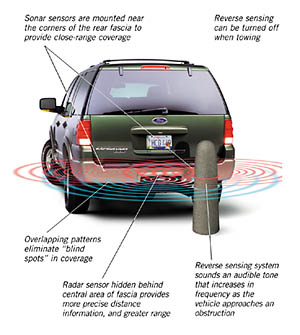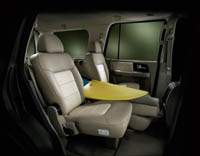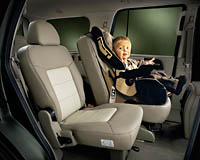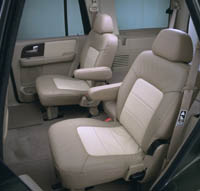2002 Ford Expedition Special Features
- An innovative second-row bench seat, split 40/20/40, offers a first-in-segment forward-sliding center section. This seating position is family-friendly, allowing easier access to young children in the second row. The sliding seat has secure, convenient LATCH child seat attachments.
- An optional walk-through second row configuration offers captain’s chair seating for two, with an open center section for easy access to the third row.
- Second- and third-row seats fold flat to create a large cargo bay that is 1.3 inches wider than before. At more than 110 cubic feet, total cargo space is among best in class and equivalent to last year’s model – but unlike competitive vehicles, there’s no need to remove any seats to achieve maximum cargo capability.
- For flexibility, the third-row seat is split 60/40. With the power-fold option on the Eddie Bauer model, each section of the third row folds independently with the push of a button.
- New sonar-radar-based reverse sensing parking aid scans a wider area, particularly closer to the vehicle where vision is more restricted, and more reliably detects objects.
- Larger sideview mirrors offer improved visibility and tilt when the vehicle is in reverse.
|
SPECIAL FEATURES Go Anywhere Without Leaving Anyone or Anything Behind “The architecture of the new 2003 Expedition was set up to ensure that customers don’t have to remove seats to access the full cargo space in their vehicle. With our increased interior dimensions and flexible, fold-flat seating configuration, the new Expedition lets you go anywhere and do anything, without leaving anyone or anything behind.” John Krafcik,
New Expedition Offers Ultimate Convenience and Flexibility Full-size sport utility customers want the roominess and flexibility to bring just about anything along with them, and they don’t want to hassle with having to remove seats. The new 2003 Expedition sets a new standard by making it easy to take full advantage of its cavernous cargo space. Expedition’s second- and third-row seats flip and fold in a host of configurations designed to accommodate nearly any combination of passengers and cargo. Efficient packaging of Expedition’s all-new independent rear suspension makes this possible – allowing a lower step-in height for four-wheel drive models and creating class-leading comfort for third-row passengers. An industry-first optional power-fold third-row seat, available in the Eddie Bauer model, offers further convenience. Key features include: Cargo-Carrying Convenience For 2003, cargo space is more usable than ever – and more convenient, building on a tradition of offering the room for Expedition owners to take almost anything anywhere. Split-fold seats allow customers to tailor the new Expedition’s interior to needs of the moment – whether it’s hauling home-improvement materials or gear for an active vacation. For heavy jobs, Expedition offers up to 1,615 pounds of total payload capacity, thanks to its robust body-on-frame construction and heavy-duty suspension. Third-Row Seating Convenience begins in the third row, where Expedition’s innovative independent rear suspension allowed engineers to lower the floor pan by 9 inches under passengers’ feet. The standard third-row seat now folds flat into this space, allowing customers to more than triple their rear cargo room in moments – without removing the seats. The third-row seat is split 60/40 for flexibility in handling long or odd-shaped cargo, while still providing room for one or two third-row passengers. For ultimate convenience, Expedition offers a power-folding option for the third row seat in the Eddie Bauer model. Separate sets of buttons on the right rear quarter panel and just behind the second-row seat on the driver’s side fold and raise the two seatback sections independently. For safety, the power-folding seat won’t operate unless the vehicle is in park, so that if an item in the rear cargo area shifts against the deployment buttons while the vehicle is moving, the seat will remain upright. Clever third-row storage features include a cargo bin on the left rear quarter panel that will hold a gallon of milk or a jug of washer fluid. All tire-changing tools reside in a hidden storage compartment under the floor. The full-size spare is housed beneath the floor pan, and is lowered using a cable winch that is accessible only from inside the vehicle, to guard against theft. The optional rear air conditioning and stereo subwoofer are housed in the rear quarter panels. Second-Row Seating Second-row seating is available in two configurations – captain’s chairs or a standard bench that is split 40/20/40, with an industry-first sliding center section. This center seat slides forward up to 11 inches, for easy access from the front passenger seat. This allows parents to more conveniently attend to the needs of their young children on the road. All three seats in the second row offer both industry-standard LATCH attachments for child seats. The LATCH system includes two metal bars between the seatback and the bottom cushion. Compatible child seats snap securely onto the bars, for convenience and safety. Top tethers help to further secure the child seat. Like the third-row seat, the new Expedition’s second row split bench folds flat for carrying cargo. Each section folds independently to accommodate a variety of needs. By folding down the outboard section of the second and 40 percent of the third rows, for example, customers can load a long item onto the cargo floor, while still leaving room for up to six passengers. With all second and third row seats folded, the new Expedition offers more than 110 cubic feet of storage space, without removing any seats.
The Expedition also offers an optional walk-through second row. The two outboard captain’s chairs in this configuration are separated by a flat-floored gap that allows convenient access to the third row. In this configuration, both second row seats have LATCH system child-seat attachments. The outboard second-row seats fold-and-flip for access to third-row seating. A new hydraulic piston helps to ease the seat back into position when it is lowered. Front-Row Seating The front seating area also offers flexibility. The split bench seat, standard in the XLT model, has a fold-down center armrest. The optional seating package, standard with the Eddie Bauer model, includes six-way power adjustable captain’s chairs and a center console that has been enlarged for 2003. The Eddie Bauer seating surfaces are leather-faced, while leather seating surfaces are optional for the XLT captain’s chairs. Eddie Bauer models also can be ordered with climate-controlled seating, which includes power passenger seats (power driver seats are standard). This offers both heating and cooling through the use of an internal heat pump inside the seat structure that delivers climate-controlled forced air through perforations in the leather seating surfaces. Controls on the center console allow separate settings for air speed and temperature for both the driver and front passenger. No other vehicle in the class offers both heating and cooling functions for the front seats. The center console – largest in the class – has enough room to keep a laptop computer safely out of sight. The console offers room to hold a pen, Palm Pilot,ä tissue box, CD and cassette storage, two cupholders for front seat occupants and two more cupholders in the rear. The rear face of the console also houses stereo controls and headphone jacks for second-row passengers with the dual-zone audio system, and rear-seat climate controls. Pampering Passengers For 2003, passenger space increases in several key areas, particularly in the third row, where the independent rear suspension enabled dramatic improvements in legroom and a more natural, comfortable seating position. The third row now offers a class-leading 36.3 inches of legroom, compared with 27 inches in the previous Expedition. Headroom increases to a class-leading 38.2 inches, up from 35 inches. The third row offers 60.1 inches of shoulder room and a class-leading 54.5 inches of hip room. Two-way height-adjustable head restraints are provided in the outboard seating positions. The third-row floor area is much flatter, thanks to package improvements created by the new independent rear suspension, for a more natural seating position. Third-row passengers don’t have to sit in an awkward knees-in-the-chest posture. A consumer study found that the Expedition’s third-row seat was rated most comfortable in the class, in both short-term and long-term use. Second-row leg and hip room also is class-leading. Headroom remains at 39.8 inches. The second-row seats recline for added comfort.
Seating materials have been refined for 2003. A new-to-the-Expedition leather seating surface, called Nudo Leather, has a softer feel and finer grain, due to additional tumbling in the tanning process, yet it retains necessary long-term durability and resists wrinkles. This two-tone leather is standard on Eddie Bauer models. The seat padding and structure in all models has been reshaped for better side support and comfort. The front seats offer a variety of manual or automatic adjustments, depending on trim level. The optional driver captain’s chair comes with a six-way power front seat; the Eddie Bauer model offers six-way power seats with a heated/cooled option for both driver and passenger. It also offers a two-person memory function that controls the driver’s seat, outside mirrors and adjustable pedals. All front seats include adjustable lumbar support. For added driver comfort, power-adjustable brake and accelerator pedals are standard, as is a steering wheel adjustable for tilt. The new Expedition’s interior design is geared toward passenger convenience and comfort. For example, the new satin-steel trim rings that surround the air vents allow quick-twist adjustment of airflow. They are knurled to offer an easy grip. Sturdy grab-handles on the A- and B-pillars assist entry and exit from the vehicle. A new grab bar above the glove compartment is positioned for passenger security in off-road operation. Interior door handles are a grab-through design in satin steel, for easy use even with thick gloves. All four door pockets offer a front bin designed to hold water bottles or other 20-ounce beverages securely. All of the driver’s frequently used interior controls were designed using computerized ergonomics programs to fall within easy “reach zones” for users of all size ranges. The new Expedition’s suspension innovations allow a step-in height that is an inch lower for four-wheel-drive models, compared with 2002, while actually increasing ground clearance under the differential by two inches and under the frame by a half-inch. The optional running board is wider than before. This combination offers the best egress and ingress Ford has ever built into a full-size four-wheel drive vehicle. Electronic Conveniences Expedition’s standard audio system combines CD and cassette capability. It offers 160 watts of peak power through four speakers. The optional Audiophile system has a six-CD changer built into the instrument panel (standard on Eddie Bauer). It powers seven speakers, including a subwoofer, with 340 watts of peak power. All seven- and eight-passenger Expeditions come with separate climate and audio controls for rear-seat passengers. An optional entertainment center adds a DVD player, headphone jacks and game ports. A 7-inch digital LCD display screen flips down from the headliner. The DVD option includes a convenient infrared remote control so passengers don’t have to lean forward to reach the “Play” button. The Expedition’s optional navigation system – the first in a Ford vehicle – is located for ease of use. The 5-inch color display screen is high on the instrument panel, for easy visibility. It is located within the normal 35 degree vertical field of vision, so the driver can keep the road in peripheral view even when consulting the navigation screen. The data CD loads into a slot above the navigation screen. A new electronic reversing aid is standard on Eddie Bauer and optional on XLT models. For the first time, it combines sonar and radar units for increased range and accuracy. The new system is a parking and back-up aid system with a range of 20 feet. This design eliminates the two external sonar transceivers toward the center of the rear fascia for improved appearance. The radar unit is hidden behind the central area of the fascia where it is protected from the elements. It “looks through” the plastic fascia to gauge distances. A power moon roof and power rear quarter panel windows are optional with controls are located on the center overhead console.  |







